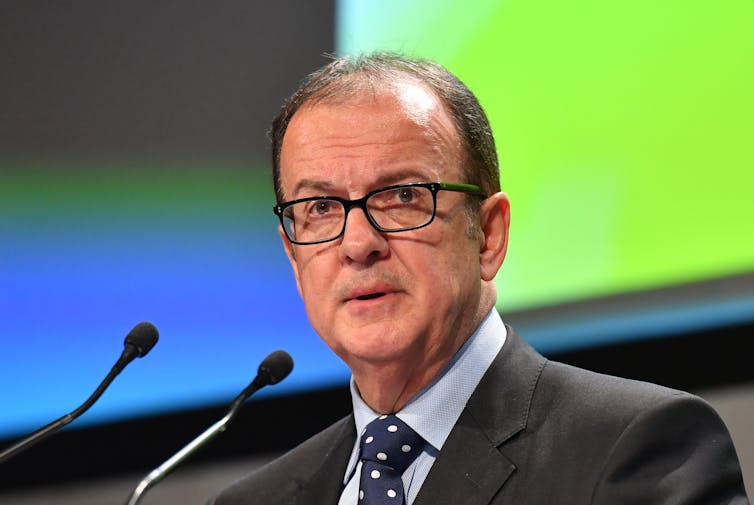No one doubts Peter Dutton has a huge task to sell his radical nuclear plan, with many experts throwing buckets of cold water over it. But on Thursday the opposition leader received some welcome backing.
Ziggy Switkowski, who headed John Howard’s 2006 nuclear inquiry that reported favourably on the potential for nuclear energy in Australia, described Dutton as “a person of conviction” and said his blueprint was feasible.
While acknowledging details were needed, including costings, Switkowski, a former chairman of the Australian Nuclear Science and Technology Organisation (and a nuclear physicist), said the scepticism about the plan was misplaced. “The strong positions some critics have taken in the last 24 hours are ridiculous.”
He said in the last 20 years the nuclear debate had been shaped by academics, the commentariat and junior politicians. Now it was being shaped by the leader of the opposition with an emerging coherent plan.
Peter Dutton and energy spokesman Ted O'Brien “are as well informed on things nuclear as any group I’ve talked to in the last 20 years in Australia,” Switkowski said, adding Dutton was “exactly right” is saying the nuclear generators should be government-owned.
Former head of the Australian Nuclear Science and Technology Organisation, Ziggy Switkowski.Darren England/AAPIn the timing of his announcement, Dutton is putting his nuclear power policy through an early stress test.
Politics often swings to and fro on the “vibe”. The vibe has recently been running against the Labor government, with polls in Nine newspapers this week suggesting Anthony Albanese doing poorly.
Parliament is about to start its final fortnight before a winter break, giving the government the chance for sustained king hits on the nuclear policy. If Labor can use the sitting to its advantage, and Dutton also takes a knock in the next polls, the “vibe” will change. The government could regain some momentum. It should be helped in this by the July 1 start of the tax cuts.
Labor is galvanised by the need to win the early post-announcement clash. Albanese is energised, with crafted lines. “This is just a fantasy,” he said on Thursday. “Instead of Snow White and the seven dwarves, this is Peter Dutton and the seven nuclear reactors.”
And, “you would have us believe that a mob who’d struggle to assemble an IKEA flat-pack are going to start from scratch and be able to develop a nuclear energy industry in Australia”. It’s unclear whether he crafts his own zingers.
Both sides claim to welcome the election being a referendum on energy. It’ll be about much more than that but energy – the government’s transition progress, the opposition’s response – will be a central battleground. With nuclear firmly out there, the weaponry is being marshalled.
By announcing the seven proposed sites for reactors, Dutton is attempting to reduce uncertainty, and counter the “would you want a reactor in your backyard?” scare.
Indeed the Coalition proposes to put the reactors – all on sites of former or current power stations – in its own backyards.
Of the seven seats involved, five are Coalition (three held by the Nationals, two Liberal). The affected part of the one Labor seat, Hunter, would transfer under the draft redistribution boundaries into the New England electorate of former Nationals leader Barnaby Joyce (a great fan of nuclear). The remaining seat, Calare, is held by independent Andrew Gee, formerly a National.
Of the seats, only one is on a margin of less than 5% (Flynn in Queensland).
Opposition sources say that in its polling, nuclear had more than 50% support in all these electorates. But the polling hasn’t been released.
Communities affected will be offered packages but there will still be local dissent over the plan. So local divisions will be running on two tracks in coming months – in the Dutton areas over the nuclear proposal, and in various other places over the rollout of transmission infrastructure and big renewable projects.
While naming the sites early is sensible, holding back the plan’s cost leaves the Coalition open to attack, especially given a major question over nuclear is that it’s so expensive.
There’s also the criticism the Coalition’s plan is pitched so far into the future it could create a big gap in the middle of Australia’s energy transition.
Dutton has abandoned Australia’s 2030 emissions reduction target; the renewed climate and energy wars are likely to hit investor confidence; and it’s not clear to what degree a Coalition government would slow the renewables rollout. All this could leave Australia in a limbo land in the late 2020s-early 2030s.
And history tells us it would be a miracle if the nuclear projects were on time or on budget (think Snowy Hydro 2).





